Atten Babler Dairy FX Indices – Nov ’15
The Atten Babler Commodities Dairy Foreign Exchange (FX) Indices declined from previously experienced record highs during Oct ’15. Despite the declines, the USD/Dairy Importer FX Index, USD/Dairy Exporter FX Index and USD/Domestic Dairy Importer FX Index all remained at the second highest figures on record throughout the month.
Global Dairy Net Trade:
Major net dairy exporters are led by New Zealand, followed by the EU-28, the U.S., Australia and Argentina (represented in green in the chart below). Major net dairy importers are led by China, followed by Russia, Mexico, Japan and Indonesia (represented in red in the chart below).
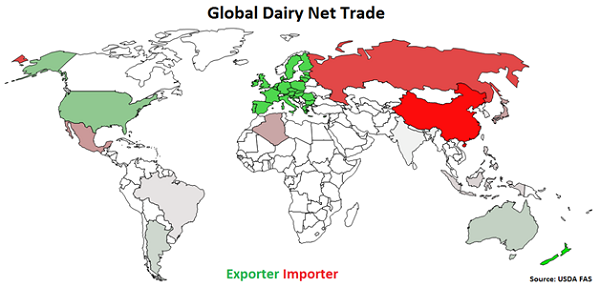 USD/Dairy Exporter FX Index:
The USD/Dairy Exporter FX Index declined 1.3 points in Oct ’15 from the record high experienced in Sep ’15 to a value of 127.0. The USD/Dairy Exporter FX Index remains at the second highest figure on record and has increased 27.2 points since the beginning of 2014 and 6.3 points throughout the past six months. A strengthening USD/Dairy Exporter FX Index reduces the competitiveness of U.S. dairy products relative to other exporting regions (represented in green in the Global Dairy Net Trade chart), ultimately resulting in less foreign demand for U.S. products, all other factors being equal. USD appreciation against the Argentine peso has accounted for the majority of the gains since the beginning of 2014.
USD/Dairy Exporter FX Index:
The USD/Dairy Exporter FX Index declined 1.3 points in Oct ’15 from the record high experienced in Sep ’15 to a value of 127.0. The USD/Dairy Exporter FX Index remains at the second highest figure on record and has increased 27.2 points since the beginning of 2014 and 6.3 points throughout the past six months. A strengthening USD/Dairy Exporter FX Index reduces the competitiveness of U.S. dairy products relative to other exporting regions (represented in green in the Global Dairy Net Trade chart), ultimately resulting in less foreign demand for U.S. products, all other factors being equal. USD appreciation against the Argentine peso has accounted for the majority of the gains since the beginning of 2014.
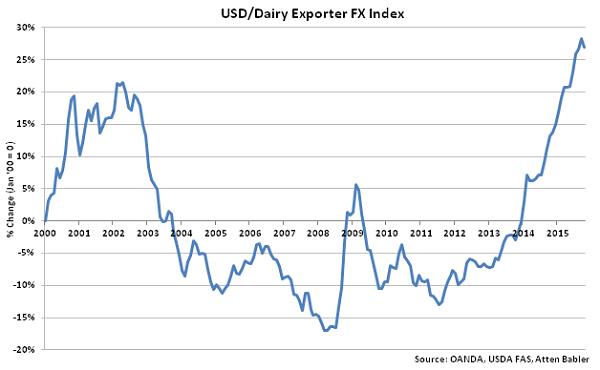 Appreciation against the USD within the USD/Dairy Exporter FX Index during Oct ’15 was led by gains by the New Zealand dollar, followed by the Australian dollar. USD gains were exhibited against the Argentine peso.
Appreciation against the USD within the USD/Dairy Exporter FX Index during Oct ’15 was led by gains by the New Zealand dollar, followed by the Australian dollar. USD gains were exhibited against the Argentine peso.
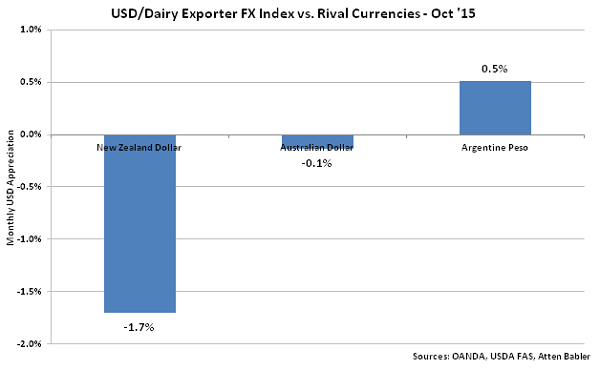 USD/Dairy Importer FX Index:
The USD/Dairy Importer FX Index declined 3.7 points in Oct ’15 from the record high experienced in Sep ’15 to a value of 142.8. The USD/Dairy Importer FX Index remains at the second highest figure on record and has increased 36.5 points since the beginning of 2014 and 13.0 points throughout the past six months. A strengthening USD/Dairy Importer FX Index results in less purchasing power for major dairy importing countries (represented in red in the Global Dairy Net Trade chart), making U.S. dairy products more expensive to import. USD appreciation against the Russian ruble has accounted for the majority of the gains since the beginning of 2014.
USD/Dairy Importer FX Index:
The USD/Dairy Importer FX Index declined 3.7 points in Oct ’15 from the record high experienced in Sep ’15 to a value of 142.8. The USD/Dairy Importer FX Index remains at the second highest figure on record and has increased 36.5 points since the beginning of 2014 and 13.0 points throughout the past six months. A strengthening USD/Dairy Importer FX Index results in less purchasing power for major dairy importing countries (represented in red in the Global Dairy Net Trade chart), making U.S. dairy products more expensive to import. USD appreciation against the Russian ruble has accounted for the majority of the gains since the beginning of 2014.
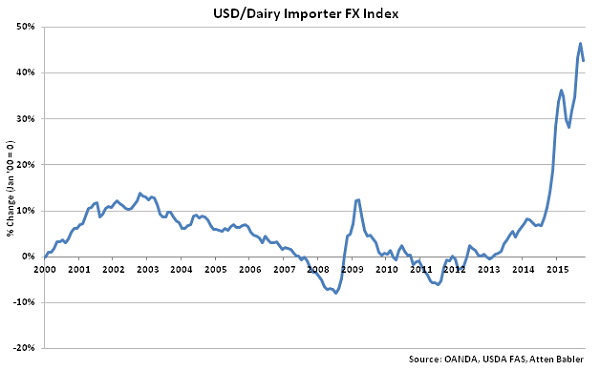 Appreciation against the USD within the USD/Dairy Importer FX Index during Oct ’15 was led by gains by the Russian ruble, followed by gains by the Indonesia rupiah, Mexican peso, South Korean won and Australian dollar.
Appreciation against the USD within the USD/Dairy Importer FX Index during Oct ’15 was led by gains by the Russian ruble, followed by gains by the Indonesia rupiah, Mexican peso, South Korean won and Australian dollar.
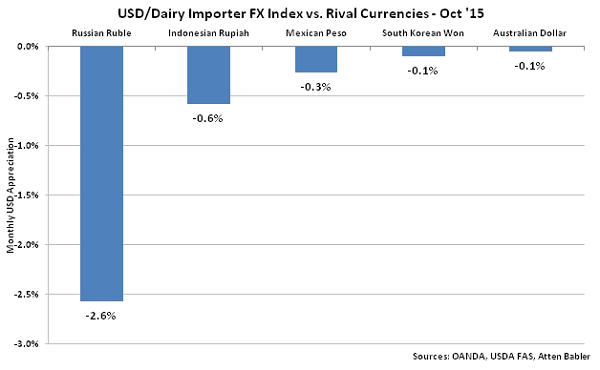 U.S. Dairy Export Destinations:
Major destinations for U.S. dairy exports are led by Mexico, followed by China, Canada, the Philippines and Indonesia.
U.S. Dairy Export Destinations:
Major destinations for U.S. dairy exports are led by Mexico, followed by China, Canada, the Philippines and Indonesia.
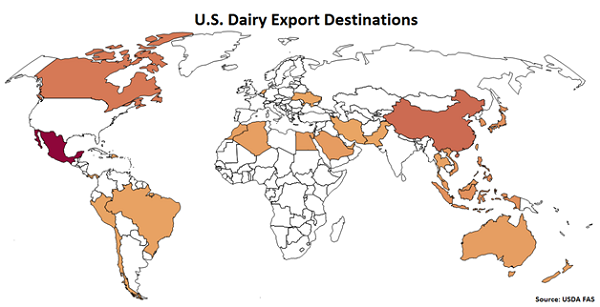 USD/Domestic Dairy Importer FX Index:
The USD/Domestic Dairy Importer FX Index declined 1.5 points in Oct ’15 from the record high experienced in Sep ’15 to a value of 145.0. The USD/Domestic Dairy Importer FX Index remains at the second highest figure on record and has increased 23.3 points since the beginning of 2014 and 8.6 points throughout the past six months. A strengthening USD/Domestic Dairy Importer FX Index results in less purchasing power for the traditional buyers of U.S. dairy products (represented in red in the U.S. Dairy Export Destinations chart), ultimately resulting in less foreign demand for U.S. products, all other factors being equal. USD appreciation against the Mexican peso, Iranian rial and Canadian dollar has accounted for the majority of the gains since the beginning of 2014.
USD/Domestic Dairy Importer FX Index:
The USD/Domestic Dairy Importer FX Index declined 1.5 points in Oct ’15 from the record high experienced in Sep ’15 to a value of 145.0. The USD/Domestic Dairy Importer FX Index remains at the second highest figure on record and has increased 23.3 points since the beginning of 2014 and 8.6 points throughout the past six months. A strengthening USD/Domestic Dairy Importer FX Index results in less purchasing power for the traditional buyers of U.S. dairy products (represented in red in the U.S. Dairy Export Destinations chart), ultimately resulting in less foreign demand for U.S. products, all other factors being equal. USD appreciation against the Mexican peso, Iranian rial and Canadian dollar has accounted for the majority of the gains since the beginning of 2014.
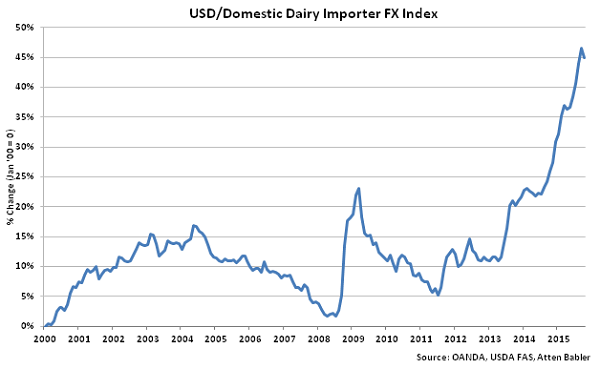 Appreciation against the USD within the USD/Domestic Dairy Importer FX Index during Oct ’15 was led by gains by the Mexican peso, followed by gains by the Indonesia rupiah, South Korean won, Canadian dollar and New Zealand dollar.
Appreciation against the USD within the USD/Domestic Dairy Importer FX Index during Oct ’15 was led by gains by the Mexican peso, followed by gains by the Indonesia rupiah, South Korean won, Canadian dollar and New Zealand dollar.
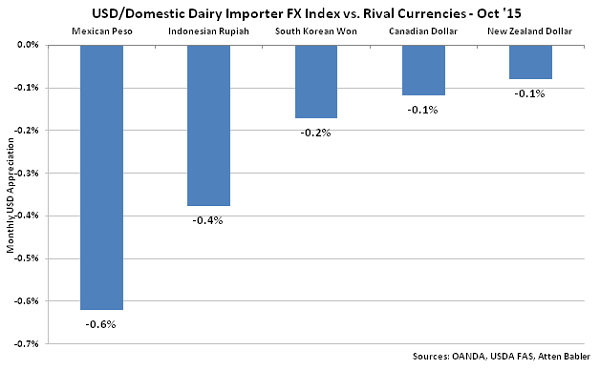
 USD/Dairy Exporter FX Index:
The USD/Dairy Exporter FX Index declined 1.3 points in Oct ’15 from the record high experienced in Sep ’15 to a value of 127.0. The USD/Dairy Exporter FX Index remains at the second highest figure on record and has increased 27.2 points since the beginning of 2014 and 6.3 points throughout the past six months. A strengthening USD/Dairy Exporter FX Index reduces the competitiveness of U.S. dairy products relative to other exporting regions (represented in green in the Global Dairy Net Trade chart), ultimately resulting in less foreign demand for U.S. products, all other factors being equal. USD appreciation against the Argentine peso has accounted for the majority of the gains since the beginning of 2014.
USD/Dairy Exporter FX Index:
The USD/Dairy Exporter FX Index declined 1.3 points in Oct ’15 from the record high experienced in Sep ’15 to a value of 127.0. The USD/Dairy Exporter FX Index remains at the second highest figure on record and has increased 27.2 points since the beginning of 2014 and 6.3 points throughout the past six months. A strengthening USD/Dairy Exporter FX Index reduces the competitiveness of U.S. dairy products relative to other exporting regions (represented in green in the Global Dairy Net Trade chart), ultimately resulting in less foreign demand for U.S. products, all other factors being equal. USD appreciation against the Argentine peso has accounted for the majority of the gains since the beginning of 2014.
 Appreciation against the USD within the USD/Dairy Exporter FX Index during Oct ’15 was led by gains by the New Zealand dollar, followed by the Australian dollar. USD gains were exhibited against the Argentine peso.
Appreciation against the USD within the USD/Dairy Exporter FX Index during Oct ’15 was led by gains by the New Zealand dollar, followed by the Australian dollar. USD gains were exhibited against the Argentine peso.
 USD/Dairy Importer FX Index:
The USD/Dairy Importer FX Index declined 3.7 points in Oct ’15 from the record high experienced in Sep ’15 to a value of 142.8. The USD/Dairy Importer FX Index remains at the second highest figure on record and has increased 36.5 points since the beginning of 2014 and 13.0 points throughout the past six months. A strengthening USD/Dairy Importer FX Index results in less purchasing power for major dairy importing countries (represented in red in the Global Dairy Net Trade chart), making U.S. dairy products more expensive to import. USD appreciation against the Russian ruble has accounted for the majority of the gains since the beginning of 2014.
USD/Dairy Importer FX Index:
The USD/Dairy Importer FX Index declined 3.7 points in Oct ’15 from the record high experienced in Sep ’15 to a value of 142.8. The USD/Dairy Importer FX Index remains at the second highest figure on record and has increased 36.5 points since the beginning of 2014 and 13.0 points throughout the past six months. A strengthening USD/Dairy Importer FX Index results in less purchasing power for major dairy importing countries (represented in red in the Global Dairy Net Trade chart), making U.S. dairy products more expensive to import. USD appreciation against the Russian ruble has accounted for the majority of the gains since the beginning of 2014.
 Appreciation against the USD within the USD/Dairy Importer FX Index during Oct ’15 was led by gains by the Russian ruble, followed by gains by the Indonesia rupiah, Mexican peso, South Korean won and Australian dollar.
Appreciation against the USD within the USD/Dairy Importer FX Index during Oct ’15 was led by gains by the Russian ruble, followed by gains by the Indonesia rupiah, Mexican peso, South Korean won and Australian dollar.
 U.S. Dairy Export Destinations:
Major destinations for U.S. dairy exports are led by Mexico, followed by China, Canada, the Philippines and Indonesia.
U.S. Dairy Export Destinations:
Major destinations for U.S. dairy exports are led by Mexico, followed by China, Canada, the Philippines and Indonesia.
 USD/Domestic Dairy Importer FX Index:
The USD/Domestic Dairy Importer FX Index declined 1.5 points in Oct ’15 from the record high experienced in Sep ’15 to a value of 145.0. The USD/Domestic Dairy Importer FX Index remains at the second highest figure on record and has increased 23.3 points since the beginning of 2014 and 8.6 points throughout the past six months. A strengthening USD/Domestic Dairy Importer FX Index results in less purchasing power for the traditional buyers of U.S. dairy products (represented in red in the U.S. Dairy Export Destinations chart), ultimately resulting in less foreign demand for U.S. products, all other factors being equal. USD appreciation against the Mexican peso, Iranian rial and Canadian dollar has accounted for the majority of the gains since the beginning of 2014.
USD/Domestic Dairy Importer FX Index:
The USD/Domestic Dairy Importer FX Index declined 1.5 points in Oct ’15 from the record high experienced in Sep ’15 to a value of 145.0. The USD/Domestic Dairy Importer FX Index remains at the second highest figure on record and has increased 23.3 points since the beginning of 2014 and 8.6 points throughout the past six months. A strengthening USD/Domestic Dairy Importer FX Index results in less purchasing power for the traditional buyers of U.S. dairy products (represented in red in the U.S. Dairy Export Destinations chart), ultimately resulting in less foreign demand for U.S. products, all other factors being equal. USD appreciation against the Mexican peso, Iranian rial and Canadian dollar has accounted for the majority of the gains since the beginning of 2014.
 Appreciation against the USD within the USD/Domestic Dairy Importer FX Index during Oct ’15 was led by gains by the Mexican peso, followed by gains by the Indonesia rupiah, South Korean won, Canadian dollar and New Zealand dollar.
Appreciation against the USD within the USD/Domestic Dairy Importer FX Index during Oct ’15 was led by gains by the Mexican peso, followed by gains by the Indonesia rupiah, South Korean won, Canadian dollar and New Zealand dollar.
